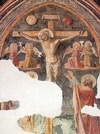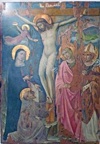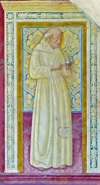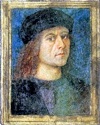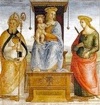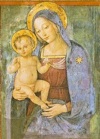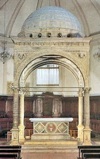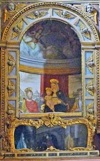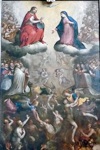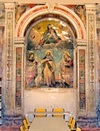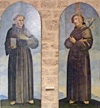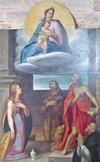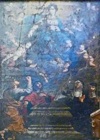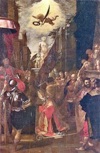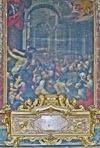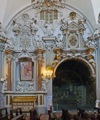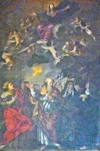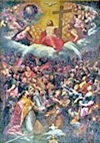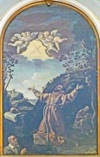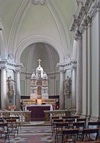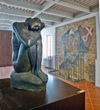

Cola Petruccioli (died 1401)
Cola Petruccioli was probably called to Spello by Pandolfo Baglioni, whom Pope Boniface IX appointed as papal vicar in 1389. Cola’s surviving works in Spello include:
-
✴a portable diptych (1391), which is signed and dated by inscription: its original provenance is unknown and it is now in the Pinacoteca Comunale;
-
✴a damaged fresco (ca. 1391) of the Agony in the Garden in the apse of Santa Maria Maggiore , which is signed and was probably originally part of a Christological cycle; and
-
✴frescoes (1393) that the Commune commissioned for San Claudio, including the bust of St Claudius illustrated here, which is possibly a self-portrait.
Maestro dell’ Assunta di Amelia (early 15th century)
These panels in the Pinacoteca Comunale, which came from a polyptych in Santa Maria Maggiore, were attributed to this master after their recent restoration. The central panel was over-painted in ca. 1500, probably by Andrea d' Assisi, l’ Ingegno (see below), and its frame probably dates to this period.
Bartolomeo da Miranda (died after 1449)
Frescoes (15th century) in Spello that are attributed to Bartolomeo da Miranda include:
-
✴those in the Oratorio di San Biagio, which include the fresco of the Madonna and Child with St Peter Martyr and St Blaise illustrated here;
-
✴the Mystic Marriage of St Catherine of Alexandria (dated 1435) on the counter-façade of San Lorenzo (which has been heavily repainted); and
-
✴the overpainting of the venerated Madonna del Latte (1373) in the Chiesa Tonda.
Giovanni Tedesco (late 15th century)
German
A miraculous Crucifix (15th century) in San Girolamo that was attributed to Giovanni Tedesco in 1994 was unfortunately stolen in 2004.
[Temporary link to Giovanni Tedesco]
Nicolò di Liberatore, l' Alunno (1430-1502)
Nicolò di Liberatore was perhaps the most important participant in the vibrant artistic milieu of Foligno in the 15th century. Frescoes (1461) in the Cappella Tega that are attributed to him depict:
-
✴the Crucifixion with the Virgin and St John the Evangelist (illustrated here); and
-
✴the Evangelists (in the vaults).
A panel of the Crucifixion (15th century) from the high altar of Santa Maria di Vallegloria (now in the Pinacoteca Comunale) is jointly attributed to Nicolò di Liberatore and Pietro di Giovanni Mazzaforte (see below).
A panel that formed the backdrop to a miraculous Crucifix in San Girolamo, which was also attributed to Nicolò di Liberatore, disappeared in the 19th century.
Pietro di Giovanni Mazzaforte (died after 1502)
Works in the Pinacoteca Comunale that are attributed to Pietro di Giovanni Mazzaforte or his workshop include:
-
✴a Crucifixion (15th century) from the high altar of Santa Maria di Vallegloria (illustrated here), which is jointly attributed to Pietro di Giovanni Mazzaforte and Nicolò di Liberatore (above); and
-
✴a processional banner (15th century) from the Oratorio di Santa Croce.
Other works in Spello with this attribution include:
-
✴frescoes (1461) in the Cappella Tega that depict:
-
•the Madonna and Child with St Anne;
-
•St Peter above the gate of Purgatory; and
-
•St Paul above a depiction of a number of women in Hell; and
-
✴a fresco of St Augustine in the vault of the Cappella del Beato Andrea, Sant’ Andrea.
Valerio de’ Muti (died after 1502)
Valerio di Giacomo de’ Muti is documented in Foligno on a number of occasions in the period 1471-1502, but no securely attributed work by him survives in his native city. A signed fresco does survive in San Girolamo, Spello.
Pierantonio Mezzastris (ca. 1430-1506)
Two frescoes in the portico of San Girolamo that are attributed to Pierantonio Mezzastris depict:
-
✴the Blessed James of the Marche holding a vial of the Holy Blood of Christ (dated 1498 by inscription and illustrated here); and
-
✴St Francis receiving the stigmata.
Bernardino di Betto, Pintoricchio (ca. 1454–1513)
Pintoricchio executed two major commissions in Spello:
-
✴the signed frescoes (1501) of the Cappella Bella, Santa Maria Maggiore, which were probably commissioned by Troilo Baglioni (which included the self-portrait illustrated here); and
-
✴an altarpiece (1506-10) of Madonna and Child with saints for the high altar of Sant’ Andrea, which Pintoricchio subcontracted in part to Eusebio da San Giorgio (see below).
A fresco of an angel (ca. 1500) above a washbasin in the ex-sacristy of Santa Maria Maggiore is also attributed to Pintoricchio.
Andrea d' Assisi, l’ Ingegno (died 1520)
The enigmatic Andrea d’ Assisi seems to have been a colleague of Pintoricchio and may have been called to Spello by the Baglioni family in ca. 1500. Two works in now in the Pinacoteca Comunale are attributed to him:
-
✴a detached fresco (probably 1503) of the Madonna and Child with SS Jerome and Bernardino of Siena from the ex-Oratorio di San Bernardino, illustrated above; and
-
✴the over-painting in ca. 1500 of a panel (early 15th century) of the Madonna and Child enthroned from Santa Maria Maggiore.
Tiberio d’ Assisi (ca. 1465 - 1524)
From Assisi
Works in Spello that are attributed to Tiberio d’ Assisi include an altarpiece (1518) of St Antony Abbot in the Cappella del Sacramento, San Lorenzo.
[Temporary link to Tiberio d’ Assisi]
Pietro Vannucci, il Perugino (1446–1524)
The elderly Perugino painted the frescoed altarpieces of two altars that flanked the presbytery of Santa Maria Maggiore in 1521. The altars were destroyed in 1644, but the altar walls and their frescoes survive in broadly their original locations. The frescoes depict:
-
✴the Pietà with SS John the Evangelist and Mary Magdalene; and
-
✴the Madonna and Child with SS Biagio and Catherine of Alexander (illustrated here).
Giovanni di Pietro, lo Spagna (died 1528)
Lo Spagna was documented in Spello on two separate occasions in 1502, and it possible that he worked with Pintoricchio (see above) on the frescoes (1501) of the Cappella Bella, Santa Maria Maggiore. This detached and largely repainted fresco (1501) of the Madonna and Child in the Cappella dei Canonici of Santa Maria Maggiore is sometimes attributed to Pintoricchio, but has more recently been attributed to lo Spagna.
Rocco di Tommaso (died 1529)
Rocco di Tommaso carried out the following work for Santa Maria Maggiore:
-
✴the tabernacle (1515) on the high altar;
-
✴two altars (1515) on the pilasters that flank the presbytery, which no longer survive; and
-
✴the design of a second bell tower, the so-called Campanile dell’ Annunziata, which was built behind and to the left of the church in 1527.
Bernardino Mezzastris (died after 1539)
From Foligno
A fresco (1533) of the Madonna and Child with saints in the now-closed Chiesa Tonda is his last known signed work by Bernardino Mezzastris.
[Temporary link to Bernardino Mezzastris]
Eusebio da San Giorgio (died after 1540)
Probably from Perugia
See Pintoricchio above.
[Temporary link to Eusebio da San Giorgio]
Giannicola di Paolo (ca. 1460-1544)
From Perugia
Giannicola di Paolo provided cartoon[s] for the inlaid furniture (1524-30) in the sacristy of San Lorenzo.
[Temporary link to Giannicola di Paolo]
Pompeo Cocchi (died after 1552)
From Perugia
Pompeo Cocchi provided cartoons for the choir stalls (1530-4) in the apse of San Lorenzo.
[Temporary link to Pompeo Cocchi]
Febo Melanzio (died 1554)
From Montefalco
Febo (Diofebo) was the nephew and student of the more famous Francesco Melanzio . Among his few documented works are the designs for the choir of San Lorenzo, Spello.
[Temporary link to Febo Melanzio]
Dono Doni (1505-75)
Works in Spello that are attributed to Dono Doni include:
-
✴the fresco (ca. 1540) of the Madonna and Child with saints on the Altare del Riscatto of San Lorenzo (illustrated here), which was recently discovered when the later altarpiece was removed; and
-
✴the altarpiece (1565) of the Virgin and St Joseph in a niche in Sant’ Andrea (the attribution of which is somewhat uncertain).
Nicolò Circignani, il Pomarancio (died 1596)
From Pomarance, near Volterra, based in Rome
Six panels (1566-7) depicting scenes from the life of St Laurence, which originally formed a frieze under the organ in San Lorenzo, are now in the sacristy of the church. One of them, which depicts the martyrdom of St Laurence, is signed by Nicolò Circignani, il Pomarancio and dated by inscription.
[Temporary link to Nicolò Circignani, il Pomarancio]
Federico Zuccari (died 1609)
The Sala degli Zuccari of Palazzo Comunale is named for the frescoes (16th century) in the frieze around it that are traditionally (but unreliably) attributed to the workshop of Federico Zuccari. They include this view of Spello (1589), which is dated by inscription.
Felice Damiani (died after 1609)
From Gubbio
Felice Damiani left a executed a number of works in his native city in the period from ca. 1594. A panel (1575) depicting the Birth of St John the Baptist in Santa Maria Maddalena, which came from the nuns’ earlier church of San Giovanni Battista, is attributed to him. If this attribution is correct, it is his earliest known work.
[Temporary link to Felice Damiani]
Francesco da Castello (died 1621)
Francesco da Castello (Frans van de Kasteele) was one of very few Flemish artists who established careers in Italy in the 16th century. He signed and dated the two panels on the altars at the ends of the aisles of San Lorenzo, which were sent to Spello from Rome. They depict:
-
✴Christ and the Virgin receive souls from purgatory (1599), which was probably commissioned by Giulio Diamante (illustrated here); and
-
✴the Martyrdom of St Catherine of Alexandria (1601), together with three smaller panels depicting scenes from the life of St Catherine, which were commissioned by Monsignor Girolamo Bevilacqua da Spello, the titular Archbishop of Nazareth.
Durante Alberti (1556–1623)
From Borgo Sansepolcro, based in Rome
The diary of Durante Alberti records three payments in 1595 from the Capuchin friars of Sant’ Onofrio for an altarpiece. They presumably brought it with them when they moved to San Severino in 1622. In fact, In fact, two panels in the church are attributed to Durante Alberti:
-
✴the panel in the left transept, which depicts the Madonna and Child in glory with SS Francis and Onuphrius and which is probably the work executed in 1595; and
-
✴the panel on the altar in the friars’ choir, which depicts the Madonna and Child with SS Bonaventure and Antony of Padua.
[Temporary link to Durante Alberti]
Ascensidonio Spacca, il Fantino (1557-1646)
Works by or attributed to Ascensidonio Spacca in Spello include:
-
✴the altarpiece of the Madonna and Child with saints (1584) in the ex-Oratorio di San Giacomo (now the Biblioteca Comunale Giacomo Prampolini), which is illustrated here;
-
✴signed frescoes of scenes from the life of the Virgin (1590) in the choir of Santa Maria di Vallegloria;
-
✴the altarpiece of the Madonna del Rosario (ca. 1590) from Santa Maria Maggiore, which is now in the Pinacoteca Comunale; and
-
✴the altarpiece of the Annunciation (1591) in San Gregorio Magno.
Andrea Camassei (1602–1649)
From Bevagna, based in Rome
Marcantonio Grecchi (1573-1651)
A number works by or attributed to Marcantonio Grecchi survive in Spello. The Pinacoteca contains five of these, all of which came from Santa Maria Maggiore. These include the Madonna and Child in glory with saints (1603), illustrated here, which is signed and dated by inscription.
Giovanni Battista Pacetti, lo Sguazzino (1593-1662)
Giovanni Battista Pacetti acquired the nickname “lo Sguazzino" because of his slap-dash methods: “sguazzare” means to splash. This altarpiece (ca. 1650) of the Madonna of the Girdle on the Altare di Santa Monica, Santa Maria Maggiore is attributed to him.
Giovanni Francesco Bassotti (died 1649)
This panel (1637) of the Martyrdom of St Felix in San Lorenzo is signed by Giovanni Francesco Bassotti and dated by inscription.
Cesare Sermei (1584- 1668)
Cesare Sermei signed an altarpiece (ca. 1610) in Sant’ Andrea that depicts a miracle of the Blessed Andrea Caccioli (illustrated here). An 18th century document recorded this signature (no longer legible), in which Cesare Sermei described himself as “Urbevetani” (from Orvieto), which suggests that the panel was painted before he became a citizen of Assisi in 1611. A number of panels (17th century) attributed to Cesare Sermei survive in Santa Maria di Vallegloria and San Ventura.
Agostino Silva (1620-1706)
The stucco decoration of many of the altars in Santa Maria Maggiore in ca. 1670 is attributed to Agostino Silva. This work includes the decoration of the Altare di San Giuseppe and the entrance to the adjacent Cappella Bella in Santa Maria Maggiore, illustrated here.
Carlo Lamparelli (died 1727)
Carlo Lamparelli served as Prior of Santa Maria Maggiore from 1716 until his death. Little else is known about him, although he probably trained in Rome. There are panels attributed to him in Santa Maria Maggiore, Sant’ Andrea, San Lorenzo, San Girolamo and the Pinacoteca Comunale. The panel in Santa Maria Maggiore, which came from Santa Chiara, depicts the Immaculate Virgin in glory, with saints (illustrated here).
Giacinto Boccanera (1666-1746)
Giacinto Boccanera painted the altarpiece (18th century) of the Trinity with saints on the high altar of San Severino.
Giacomo Giorgetti (1603-1679)
This altarpiece (ca. 1652) in Santa Maria Maggiore, which depicts the stigmatisation of St Francis is attributed to Giacomo Giorgetti. It is one of the few works by or attributed to him that survive outside Assisi.
Giuseppe Piermarini (1734 - 1808)
Giuseppe Piermarini designed the Cappella del Sacramento of San Lorenzo in 1793, while he was still based in Milan.
Emilio Greco (1913-95)
Emilio Greco moved to Rome in 1943 and was Professor of Sculpture at the Liceo Artistico there in 1948-52. Among his last works was the monument (1965–6) to Pope John XXIII in St Peter's, Rome. He exhibited in the exhibition “Incontri per le Strade” in Spello in 1983 and was made a citizen of the city in 1985. He donated a number of works to the city in 1989. These are now exhibited on the three rooms on the second floor of Palazzo Comunale Vecchio. They include this painted chalk figure (1971) called "l’ Accoccolata" (the crouching woman).





